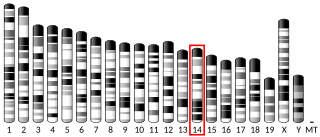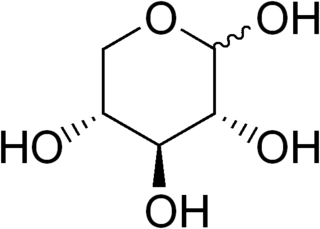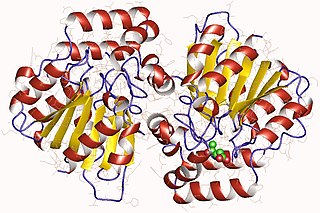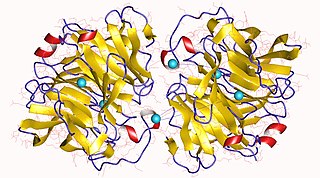
Gamma-butyrolactone (GBL) or γ-butyrolactone is an organic compound with the formula O=CO(CH2)3. It is hygroscopic, colorless, water-miscible liquid with a weak, characteristic odor. It is the simplest 4-carbon lactone. It is mainly used as an intermediate in the production of other chemicals, such as N-methyl-2-pyrrolidone.

L-Gulonolactone oxidase is an enzyme that produces vitamin C. It is expressed in mice and rats, but is non-functional in Haplorrhini, in some bats, and in guinea pigs. It catalyzes the reaction of L-gulono-1,4-lactone with oxygen to form L-xylo-hex-3-gulonolactone (2-keto-gulono-γ-lactone) and hydrogen peroxide. It uses FAD as a cofactor. The L-xylo-hex-3-gulonolactone then converts to ascorbic acid spontaneously, without enzymatic action.The structure of L-gulonolactone oxidase in rats helps identify characteristics of this enzyme.

D-Xylose is a five-carbon aldose that can be catabolized or metabolized into useful products by a variety of organisms.
In enzymology, a D-arabinose 1-dehydrogenase (EC 1.1.1.116) is an enzyme that catalyzes the chemical reaction
In enzymology, a D-xylose 1-dehydrogenase (NADP+) (EC 1.1.1.179) is an enzyme that catalyzes the chemical reaction
In enzymology, a D-arabinose 1-dehydrogenase [NAD(P)+] (EC 1.1.1.117) is an enzyme that catalyzes the chemical reaction
In enzymology, a d-galactose 1-dehydrogenase (EC 1.1.1.48) is an enzyme that catalyzes the chemical reaction
In enzymology, a glucuronolactone reductase (EC 1.1.1.20) is an enzyme that catalyzes the chemical reaction
In enzymology, a L-xylose 1-dehydrogenase (EC 1.1.1.113) is an enzyme that catalyzes the chemical reaction
In enzymology, a L-galactonolactone oxidase (EC 1.3.3.12) is an enzyme that catalyzes the chemical reaction
In enzymology, a D-arabinono-1,4-lactone oxidase (EC 1.1.3.37) is an enzyme that catalyzes the chemical reaction
The enzyme 1,4-lactonase (EC 3.1.1.25) catalyzes the generic reaction

The enzyme 3-oxoadipate enol-lactonase (EC 3.1.1.24) catalyzes the reaction
The enzyme D-arabinonolactonase (EC 3.1.1.30) the reaction
The enzyme deoxylimonate A-ring-lactonase (EC 3.1.1.46) catalyzes the reaction

The enzyme gluconolactonase (EC 3.1.1.17) catalyzes the reaction
The enzyme limonin-D-ring-lactonase (EC 3.1.1.36) catalyzes the reaction
The enzyme L-rhamnono-1,4-lactonase (EC 3.1.1.65) catalyzes the reaction

Lactonase (EC 3.1.1.81, acyl-homoserine lactonase; systematic name N-acyl-L-homoserine-lactone lactonohydrolase) is a metalloenzyme, produced by certain species of bacteria, which targets and inactivates acylated homoserine lactones (AHLs). It catalyzes the reaction
Acyl-homoserine lactone acylase may refer to:






